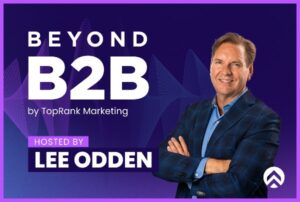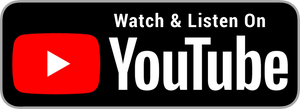In this episode of the Beyond B2B Marketing Podcast., host Lee Odden sits down with Kathleen Booth, Senior Vice President of Marketing and Growth at Pavilion, to explore the rising importance of community in B2B marketing.
Kathleen shares her personal journey from member to executive at Pavilion and reflects on the core challenges facing go-to-market leaders today: high turnover, intense pressure, and a rapidly changing business landscape. She explains how Pavilion addresses these challenges by creating a space for senior professionals to connect, learn from peers, and develop the leadership skills often overlooked in traditional training environments.
Kathleen emphasizes that community is not a short-term effort. It’s a long-term brand strategy that requires dedicated resources, leadership buy-in, and a commitment to member experience. She highlights the distinction between communities of product, practice, and interest, and urges B2B brands to choose a model that aligns with their business goals before getting started. We also talked about LinkedIn, Reddit and sources of inspiration.
Takeaways from this episode include:
- Size can negatively impact community quality and engagement.
- In-person events are crucial for building trust and relationships.
- Building a community can be more beneficial than direct sales.
- Reddit offers a unique advertising opportunity but requires careful strategy.
- LinkedIn can be used for thoughtful engagement rather than just distribution.
- AI can enhance content creation while maintaining personal voice.
- Setting expectations is key to successful teamwork and leadership.
- Finding fulfillment in work can positively impact others’ lives.
- Personal branding is integral to modern marketing success.
Listen to the full podcast with Kathleen here:
Or you can watch the interview on YouTube:
Here’s a text summary of our conversation:
Lee: Hello and welcome to the Beyond B2B Marketing Podcast. I’m your host, Lee Odden, CEO of TopRank Marketing. Today, we’re talking with a B2B marketing leader who truly embodies the term “marketer’s marketer.” She’s started and sold an agency, led marketing at multiple companies, and is now Senior Vice President of Marketing and Growth at Pavilion, a private community for over 10,000 go-to-market leaders. I’m talking about Kathleen Booth. Welcome, Kathleen.
Kathleen: Hi, Lee. Thanks for having me on. I’m very honored to be here.
Lee: It’s great to have you. We’ve known each other for a long time, and it’s nice to bring our real-world connection into the digital-and hopefully back out again when we’re both at Cannes next year.
Kathleen: We’re making it happen. We’ve put it out into the universe. So it shall be.
Lee: Exactly. Let’s start by helping folks understand Pavilion and your role there.
Kathleen: I was actually a member before I joined Pavilion. I’d been working in B2B tech, mainly as an early-stage marketing leader. Back in 2019, I was job hunting and shared my resume with some marketers I respected. Suddenly, I started getting interviews with NYC tech companies-even though I live in Annapolis, Maryland. I asked how they heard of me, and they all mentioned the New York Revenue Collective, which was Pavilion’s former name. My resume had been shared there. I thought, “Wow, I need to be part of this network.”
I joined, eventually became co-chair of the DC chapter, and in 2022 had the opportunity to step into the Head of Marketing role. As a marketer, it was amazing to market something I’d already experienced and deeply valued. It’s been almost three years, and it’s been a lot of fun.
Lee: You’re definitely in the right role. I heard about Pavilion because of you. You’ve been a great ambassador and thought leader. So, who are the typical Pavilion members?
Kathleen: Pavilion isn’t just for marketers-we serve go-to-market leaders. That includes heads of sales, marketing, customer success, RevOps, partnerships, and even CEOs. Our members are typically V- or C-level operators who report to the CEO. These roles are high-pressure and constantly evolving, especially with how fast AI is reshaping things.
We also serve director-level professionals-the future leaders-helping them build both their skill sets and leadership muscles. For executive-level members, it’s not about teaching them how to run a demand gen campaign. We assume they’re already good at marketing. It’s about helping them master unit economics, lead teams, communicate effectively, and understand cross-functional peers like CROs and CFOs.
Lee: That’s a really strong differentiation. I’ve seen research showing that marketing leaders need business acumen more than ever. You’re empowering people to meet that demand.
Kathleen: Exactly. The challenge that birthed Pavilion is that people in these roles don’t last long-on average, only about 18 months. The stress and volatility are real, and people need a support system. They also need fast, peer-driven learning. You’ll never be able to read enough books or listen to enough podcasts to stay current. But in a community, you’re learning from people in the trenches who are testing things in real time.
Lee: Absolutely. It takes a village. So what are people really looking for when they join?
Kathleen: It varies. I’ve been mapping out what I call “moments that matter” in someone’s career-moments that drive them to seek community. Getting a new job is a big one. If you’re a first-time CMO, you need a 90-day plan. Books help, but a peer community can tell you what really works.
Often, people come for specific courses like CMO School. Maybe they just got promoted, raised a funding round, have a new CEO, or were laid off. The course solves an immediate problem, and they stay for the network. Sometimes, they join because everyone in their LinkedIn feed is already a member. Pavilion has served different needs for me at different points in my career-from job seeking to networking to leadership development.
Lee: Clearly community has a purpose in professional growth. But what about B2B brands? Should they be building communities too?
Kathleen: It depends. I’ve worked for companies that did and didn’t build communities. Community can be a powerful growth lever-but only if you’re prepared to invest for the long term. It’s not a three-month play to generate pipeline. It’s a brand play, and leadership needs to support it.
I once worked at an agency called Impact, where we had a 5,000-member Facebook community. It worked because our CEO hired a full-time community leader whose job was to engage daily, answer questions, and make connections. Where communities fail is when brands focus only on getting people in and have no plan for what happens next. That’s where the magic is.
Lee: Right-what happens if you succeed? You need a plan.
Kathleen: Exactly. I’ve seen it succeed at all stages of business-from scrappy startups to enterprise. It’s all about how you view ROI and how you resource it. If you do it right, almost any business can benefit.
Lee: It’s a relationship. You can’t just turn it on or off. It takes commitment.
Kathleen: And habit. You need to build the habit among your members to keep showing up. That only happens with regular, ongoing value.
Lee: When choosing a model, you’ve talked about product, practice, and interest communities. How should a brand decide?
Kathleen: You absolutely need a strategy. Product communities are users of your platform. Practice communities-like Pavilion-are organized around a discipline, like go-to-market. Interest communities are broader, like entrepreneurship or fitness. Each requires different levels of investment and has different goals. Pick the one that aligns with your business objectives.
Lee: Do you see more intentional or opportunistic communities out in the wild?
Kathleen: Both. There’s the crawl-walk-run model. For example, Wednesday Women started as a weekly LinkedIn post and small events. Now it’s a full membership community. That’s smart-prove the concept before you go all in. But some companies do go all in right away, and if they have a solid strategy and resources, that can work too.
Lee: What causes communities to plateau or fall apart?
Kathleen: It often comes down to commonality-or a lack of it. Community is ancient. In archaeology, they look for signs like shared location, language, and rituals. Same applies in digital B2B. If you move platforms without care, if you grow too fast and lose relevance, or if there’s no clear shared identity, things fall apart. The challenge is maintaining intimacy and trust even as you scale.
Lee: What about events? Do they matter?
Kathleen: Events are essential. Pavilion grew fastest during COVID through virtual connection, but in-person is irreplaceable. The emotional glue of community doesn’t really set until people meet face-to-face. Our members often hug when they meet-even if it’s the first time. That’s the power of trust and belonging. Events also play a huge role in marketing by building durable, in-person trust.
Lee: That reminds me of when we met-at the 2019 B2B Marketing Forum. Meaningful experiences like that stick.
Kathleen: Totally. I can barely remember yesterday’s lunch, but I remember that dinner in detail.
Lee: You mentioned Clay as a good example. Any other B2B brands doing community well?
Kathleen: Sixth Sense is a standout. Their CMO Coffee Talk started as a breakfast series, then turned into a full community. They’ve played the long game and avoided turning it into a sales channel. Everyone knows Sixth Sense is behind it, but they don’t pitch. It builds pipeline anyway-just more authentically.
Lee: That’s the return on relationship. So, Pavilion is advertising on Reddit now. What’s that been like?
Kathleen: We’re experimenting. I’ve done it before in ad tech. Redditors are skeptical of ads, so you have to be careful. But the CPC is much lower than LinkedIn, and Reddit has good targeting based on community membership. Plus, Reddit data feeds a lot of LLMs. It’s early, but we’re seeing promising results.
Lee: Smart. You have to show up where your audience is. Speaking of which, your LinkedIn presence is incredibly strong. Any advice?
Kathleen: I always joke that I’m the least intentional creator. I started posting around 2017 when the “broetry” wave hit. I challenged myself to post every day for a year-no agenda, just sharing what I was learning. I assumed if something was helpful to me, it might be to others. I didn’t sell. I just showed up and added value.
Over time, I worked for CEOs who saw it as a distraction. But when I got to Pavilion, Sam Jacobs got it. He sees personal brand as part of the job. That support unlocked a lot for me. I now use Otter to voice-record my ideas, then use ChatGPT to help package the message. Every idea is mine-I just use AI for efficiency, not creativity.
Lee: Makes total sense. It’s like having an editor. Any lessons you’ve learned outside of work that apply to marketing?
Kathleen: Absolutely-communication. Marriage taught me a lot about owning 200% of a conversation. Sailing did too. I used to crew on a racing boat. If the skipper didn’t say “ready to tack” before turning, you could go overboard-which I did once, in November! Clear, proactive communication is everything in leadership.
Lee: Love that analogy. So what keeps you inspired?
Kathleen: I genuinely love what I do. I attach a lot of fulfillment to my work. I’ve been a founder, I’ve failed, and I’ve seen how marketing impacts people’s lives and livelihoods. At Pavilion, I get to help grow a business while helping other people succeed in critical career moments. That’s incredibly rewarding.
Lee: That’s a perfect note to end on. Where can people find you?
Kathleen: You can learn more at joinpavilion.com or connect with me on LinkedIn. Just mention this podcast!
Lee: Thank you so much for being on the show, Kathleen.
Kathleen: Thanks for having me.
To find the Beyond B2B Marketing podcast on your preferred podcast platform, check out the links below.





